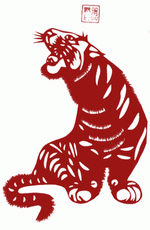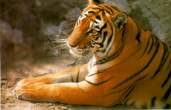 |
| Dragon and tiger in folk art (II) |
 A legend has it that on a mountain, there was a peach tree and under the tree stood two brothers. Whenever the two found any evil spirit, they fed them to a tiger. Thus, the tiger has the power to expel evils. According to some researchers, the tiger also symbolizes marriage and reproduction. However, customs differ from one place to another. A legend has it that on a mountain, there was a peach tree and under the tree stood two brothers. Whenever the two found any evil spirit, they fed them to a tiger. Thus, the tiger has the power to expel evils. According to some researchers, the tiger also symbolizes marriage and reproduction. However, customs differ from one place to another.
In Shaanxi province, the bride will receive two dough tigers when she arrives at the gate of the bridegroom’s home. There is a custom of hanging tiger ornaments on the bed of a newly wed couple. In Henan province, a temple fair is held at Fuxi in the third lunar month and tiger toys made of various materials are sold. Many people go there to pray for a child and then bring a tiger toy home with them. One such toy is usually made up of two tigers to symbolize a man and a woman.
In Chinese legends, there are quite a few tales about how tigers saved human lives. One story says in the ancient state of Chu, a man had an illegitimate child whom he abandoned in a desolate field. A female tiger found the child and fed him with her own milk. Later, the child grew up to become the prime minister of the state of Chu.
Maybe, the most famous man supposedly saved by a tiger is the great philosopher, Confucius. It is said that Confucius was so ugly when he was born that his parents decided to leave him on a mountain. Again, it was a tiger that saved his life. The theme of “tiger-feeding man” is, therefore, also popular in paper-cuts and embroidery.
Tigers were worshipped not only by the majority Han people, but also by more than a dozen minority ethnic groups. One example is the Yi Nationality. Yi people have a tiger festival every year. On that day, all people dress up to look like tigers and hold all kinds of celebrations.
 The worship of the tiger can be found in most parts of China. The tiger theme used to be so popular that you could find many kinds of tiger objects in one household. You might see a tiger head made of cloth hanging on the gate, tiger paper-cuts on the window, tiger pillows and quilts on the bed, a tiger cake on the table and tiger caps, shoes and toys for children. The worship of the tiger can be found in most parts of China. The tiger theme used to be so popular that you could find many kinds of tiger objects in one household. You might see a tiger head made of cloth hanging on the gate, tiger paper-cuts on the window, tiger pillows and quilts on the bed, a tiger cake on the table and tiger caps, shoes and toys for children.
In the past, folk art works of tigers were usually made by women in the countryside. They made these for practical as well as aesthetic purposes. The skill was passed down from mother to daughter and a woman of talent would spread her skill to another village when she married to a man from that place. Most of these women were illiterate and spend their entire lives in one small area in the countryside. So it is a wonder how the original pattern could have been passed down for generations and spread from the isolated villages to all over China.
|
|
|













